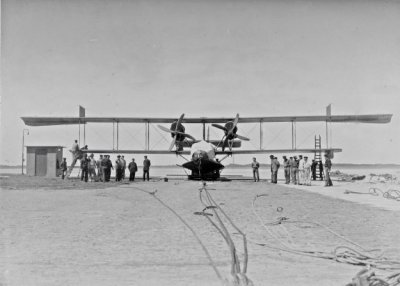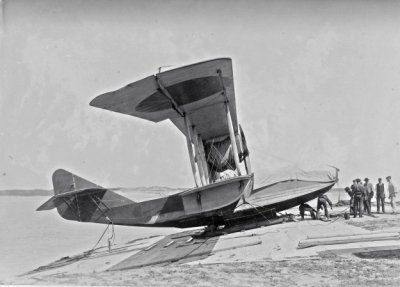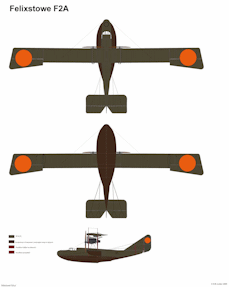Felixstowe F2A
History
In 1914 the Glenn Curtiss Company developed a flying boat. The Curtiss H-4 was developed from this aircraft.
The British RNAS officer John Porte had good connections with Curtiss and he did much research in finding the correct hull. The H-4 had difficulties in taking off, especially with full load.
Several hulls were tested, often with one aircraft. [this is the reason why several photos exist of aircraft with the same serial equipped with different hulls. In the end the Curtiss H-8 was developed, which was ordered by the RNAS is rather large quantities.
Development of the hull still continued and also at RNAS Station Felixstowe several tests with modified hulls were done, resulting in the Felixstowe F.1
Curtiss had developed the Curtiss H.12, with an improved hull. Also the Curtiss H-12 was used for several tests at RNAS station Felixstowe.
Porte also designed a new hull for the Curtiss H.12. The aircraft, designation Felixstowe F.2, equipped with this new hull and two 345 hp Rolls Royce Eagle engines and the wings and tail of the Curtiss H.12 made its maiden flight in July 1916.
In the end 100 examples were built.
| Dimensions: | |||
| Length: | 14,02 m | Wingspan: | 28,34 m |
| Height: | 5,09 m | Wing area: | 102,9 m2 |
| Weights: | |||
| Empty weight: | 2880 kg | Max. start weight: | 4124 kg |
| Performances: | |||
| Max. speed: | 149 km/u | Rate of climb: | - m/min |
| Range: | - km | Service ceiling: | - m |
| Miscellaneous: | |||
| Engine type: | Two Rolls Royce Eagle I rated 250 hp each. | ||
| Crew: | Three men | ||
| Armament: | Three machine guns | ||
| Dimensions: | |||
| Length: | 14,09 m | Wingspan: | 29,12 m |
| Height: | 5,33 m | Wing area: | - m2 |
| Weights: | |||
| Empty weight: | 3424 kg | Max. start weight: | 4979 kg |
| Performances: | |||
| Max. speed: | 151 km/u | Rate of climb: | - m/min |
| Range: | 6 hrs | Service ceiling: | - m |
| Miscellaneous: | |||
| Engine type: | Two Rolls Royce Eagle VIII rated 345 pk each | ||
| Crew: | Four men | ||
| Armament: | Three machine guns | ||
Two aircraft were interned and used by the RNlNAS, Felixstowe F-2A, N4551, receiving serial L-1, and Curtiss H-12, receiving serial L-2
Very little is known about these aircraft in Dutch service. They were withdrawn from use very soon.

[Enclosed photo from BeeldBank NIMH. Click on photo for ordering information]

[Enclosed photo from BeeldBank NIMH. Click on photo for ordering information]
| Serial | Constr.nr. | RFC Serial | Date in service | Date out of service | Notes |
|---|---|---|---|---|---|
| L-1 | N4551 | 04-06-1918 | 12-1918 | Felixstowe F-2A. December 1918 struck of charge |
|
| L-2 | 8689 | 02-10-1918 | 12-1918 | Curtiss H-12; December 1918 struck of charge |
As far as I know no model of the Curtiss H-12 is released, perhaps it can be converted from an Felixstowe F.2A model.
1/72nd Scale
Kits
- Aeroclub
- Kit 308: Felixstowe F.2A; I don't know whether this is the right version
- Roden
- Kit 047: This is a late version with open cockpits and a gunner position on the upper wing.
- Kit 049: Curtiss H16, a license built Felixstowe F2A
- Kit 019: Early version of the F-2A with closed cockpits. This is the version which was used by the RNlAS.
- Kit 014: Probably an early version.
Modelling add-on
- Aeroclub
- Set E069: Rolls Royce Eagle V12 (Felixtowe F2A)
- Set E070: Wooden 4 Bladed Prop (Felixtowe F3)
- Extra Tech
- Set EX72148: Detailset Felixtowe F2A (Roden)
- Part Etchings
- Set S72-221: Detailset Felixtowe F2A (Roden)
Decals
- --
- Set --: --
1/48th Scale
Kits
- --
- Kit --: --
Modelling add-on
- --
- Set --: --
Decals
- --
- Set --: --
Hardly any photo's are known of these aircraft in RNlNAS service.
The aircraft were rather dark, most probable the standard RNAS paint scheme. This was a black anti-fouling" on the hull. Other parts were painted with copal-varnish.
From mid 1916 the aircraft of the RNAS were camouflaged, upper surfaces of wings, fuselage, etc. were khaki.
| Scheme | Colour name | FS number | BS number | Humbrol | XtraColor | Vallejo Model Color | Vallejo Model Air | |
|---|---|---|---|---|---|---|---|---|
| Standard #1 | Underside Fuselage | Black - Dark brown | ~7078 | 33 | 70.950 | 71.057 | ||
| Remaining parts | Khaki or olive green 9PC10) | 170 | 70.871 | 71.029 | ||||
Check www.paint4models.com for an extensive conversion table with lots of colour and paint systems.
Literature.
| Nederlandse Marinevliegtuigen | Thijs Postma & Nico Geldhof | Pag. 9 | 1978 | Uitgever Omniboek, 's Gravenhage |
| Aircraft Archive Aircraft of World War One; Volume 3. | Pag. 22 - 25 | 1989 | Uitgever: Argus Books, Hempsted | |
| Camouflage en Kentekens | J.Greuter e.a. | 1997 | Bonneville – Bergen (NH) | |
| Windsock datafile 82: Felixstowe F.2A | J.M. Bruce | 2000 | Uitgever AMBooks, Bromley, Kent | |
| Air Enthusiast no.80, The Historical Aviation Journal: Unexpected Windfalls | Bart van der klaauw | Pag. 54 - 59 | 1999 | Uitgever Key Publishing Plaats: Stamford |
| 85 JAAR Marineluchtvaartdienst in beeld; Van Farman tot NH 90 Helikopter | Peter Korbee | pag. 21 | 2002 | Uitgever Korbee MLD Promotie, Valkenburg |
Websites.
- World War 1.com: Curtis H12
- World War 1.com: Curtis H16
- Glennhcurtiss.com
- RCAF.com: Curtiss H-12
- RCAF.com: Curtiss H-16
- RCAF.com: Felixstowe F2a/
- WWI Fighters; FElixstowe F-2A
- Aviation History.: Felixstowe F-2A
- British Aricraft.com: Felixstowe F-2A
- WillHiggs.com: Felixstowe F-2A
- Felixstowe F-2A
- Wikipedia UK: Felixstowe F-2A
